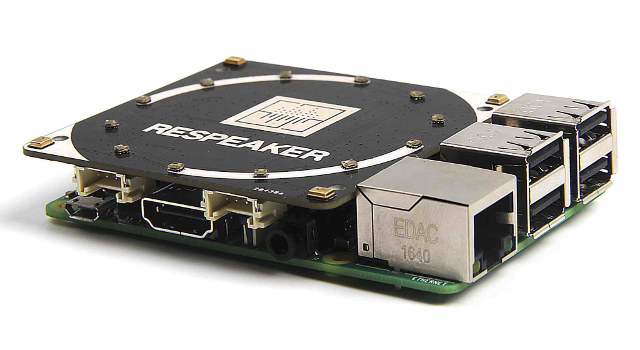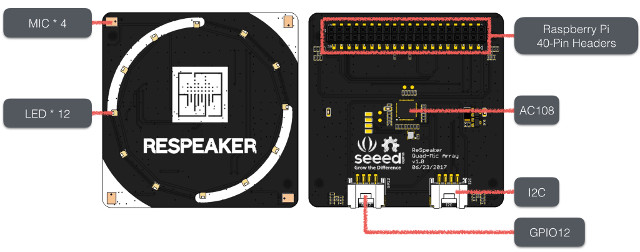Last year, Seeed Studio launched ReSpeaker WiFi Audio / IoT board based on Mediatek MT7688, as well as an optional microphone array board with 7 microphones and 12 LEDs. Later on, they introduced a $10 2-mic array board for Raspberry Pi Zero (W), and today the company has started to take orders for ReSpeaker 4-Mic Array for Raspberry Pi board for $24.50 plus shipping.

Respeaker 4-Mic Array board specifications:
- Audio
- X-Powers AC108 quad-channel ADC with I2S/TDM output transition
- 4 Microphones
- Expansion
- 2x Grove interfaces (1x I2C, 1x GPIO port using pins 12 & 13)
- 40-pin Raspberry Pi compatible header
- Misc – 12 LEDs (APA102) connected over SPI, GPIO5 enables power
- Dimensions – 65mm x 65mm x 9mm
- Weight – ~20 grams
 The board will give Raspberry Pi board the ability to do Voice Activity Detection (VAD) aka “hot word” detection, estimate Direction of Arrival (DoA) and show the direction via the LED ring, just like Amazon Echo or Google Home. I’m using an Orange Pi Zero board with a single microphone with Google Assistant and while it works fine most of the times range is limited to about 5 meters, and “OK Google” detection may be a problem with background noise like music. For example, I’ve found out it may be tricky to turn off the alarm with “OK Google. Stop” while it is ringing. Such board should help.
The board will give Raspberry Pi board the ability to do Voice Activity Detection (VAD) aka “hot word” detection, estimate Direction of Arrival (DoA) and show the direction via the LED ring, just like Amazon Echo or Google Home. I’m using an Orange Pi Zero board with a single microphone with Google Assistant and while it works fine most of the times range is limited to about 5 meters, and “OK Google” detection may be a problem with background noise like music. For example, I’ve found out it may be tricky to turn off the alarm with “OK Google. Stop” while it is ringing. Such board should help.
You’ll find a getting started guide & Google Assistant tutorial on Github, where you can also download the hardware design files (PDF and Eagle), and X-Power AC108 datasheet (currently wrongly? linking to “AC101 user manual”).

Jean-Luc started CNX Software in 2010 as a part-time endeavor, before quitting his job as a software engineering manager, and starting to write daily news, and reviews full time later in 2011.
Support CNX Software! Donate via cryptocurrencies, become a Patron on Patreon, or purchase goods on Amazon or Aliexpress





Hi, thanks for the article, few question:
1. Why installing Google Home or Alexa on a Pi where their devices are so cheap and goog quality ?
2. What about alternatives ? Snowboy do not work very well and is “half” proprietary
3. Why a Pi ? Speech Synthesis is very very bad on Linux compared to SAPI voices on Windows
Customize wake up words and commands
They are using Snowboy. Snowboy is only free for personal use and no source code access.
https://snowboy.kitt.ai/
Snowboy works, it just isn’t free. You need to train it to improve its performance.
@Jean-Philippe Encausse These devices aren’t intended for your average consumer. If you want something that just works, go get a Google Home, Echo, etc. These are for people who want to tinker and experiment. #1a. You have access to a range of different tools and addons and can configure the device to do other things that Home/Alexa/PI cannot. e.g. control home automation without having to go back to a cloud server. #1b. You have more visibility into what your device is doing an when. Quite a few people (myself included) don’t trust Google Home/Alexa/etc in our homes. #2. See 1a.… Read more »
I’m kinda interesting in exploring this space. So will this system show up on your system as 4 microphones? How do you go about ensuring they’re perfectly in sync? (maybe some kind of time stamped buffers?)
I figured since you need to deal with very sensitive timing between microphones that this would have to be done on a dedicated DSP micro b/c you can’t tolerate latencies, OS interrupts etc.
I guess this is a bit out of my bailiwick 🙂 Can anyone point to any resources to getting started working on audio?